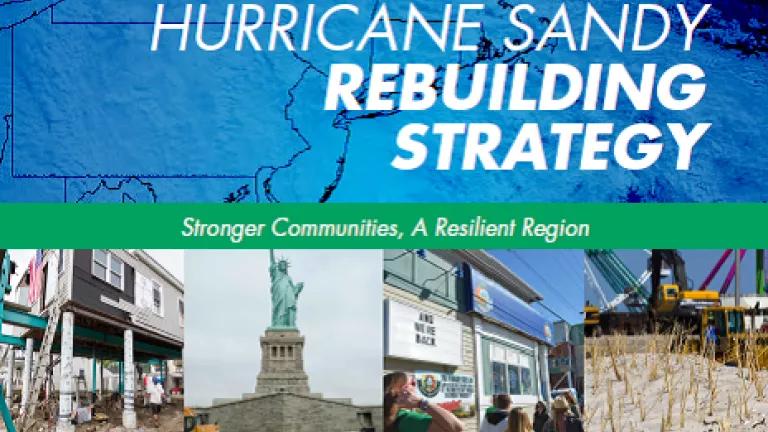
On Monday President Obama’s administration released its Hurricane Sandy Rebuilding Strategy, a 69-point plan that could serve as the template for post-disaster rebuilding efforts in the future and might also serve as a national template for climate preparedness.
Perhaps the most interesting and novel aspect of the Rebuilding Strategy is that the emphasis is not just rebuilding, but to rebuild in a way that protects against future disasters and reduces the region’s overall risk from climate-related natural disasters like sea level rise, flooding, extreme weather, and coastal erosion.
As the report flatly states,
“It is vital that science-based tools and the best available data are used to better anticipate community vulnerabilities for future disasters and to adopt measures that will reduce future human, economic, and environmental costs.”
It is encouraging to hear, given that past disasters have often led to a very different type of rebuilding effort, usually driven by calls for higher levees and stronger sea walls, which can only do so much.
The Rebuilding Strategy indicates that the solutions that emphasize resilience and sustainability are now the preferred solutions. Moreover the Rebuilding Strategy clearly recognizes the importance of preparing for a climate future that presents more extreme weather and greater risks than the past would seem to indicate.
Green Infrastructure Guards Against Flooding, Storm Surges
What’s often called “green Infrastructure” is a focus of the recommendations. The Rebuilding Strategy includes guidelines for all federal infrastructure spending associated with Sandy recovery efforts and they place an emphasis on green infrastructure.
The administration’s plan voices unprecedented support for evaluating and using, wherever possible, green infrastructure when considering how to best manage stormwater, reduce the risks of flooding, and to protect our coastlines from erosion and storm surges. The administration’s plan recommends that agencies, “Consider green infrastructure options in all Sandy infrastructure investments.” It goes on to state,
“Rather than just rebuilding damaged infrastructure to its pre-disaster standard, these Guidelines and other proposals within the Rebuilding Strategy, encourage construction of sustainable and resilient infrastructure built to better withstand future disasters.”
|
At the national level and in cities around the country, we are seeing growing interest in green infrastructure.
|
Safeguarding Our Drinking Water & Stopping Sewage Overflows
In the wake of Hurricane Sandy, drinking water and wastewater infrastructure were heavily impacted.
Once again, the Rebuilding Strategy defines a path forward that breaks with past conventions. Previously, in the aftermath of a natural disaster, most communities would rebuild their water and sewage treatment plants along the same lines of what existed before. Now, a new emphasis is being put on resiliency, sustainability, and long-term operational efficiency and effectiveness.
And the commitment is being backed by real dollars. FEMA will spend more than $1 billion to rebuild and repair sewer and drinking water infrastructure and these funds can also be used for resilience and mitigation efforts as well. USEPA will be sending $570 million to New York and New Jersey to support resiliency and sustainability improvements to those states’ wastewater and drinking water plants. New York’s plan for how it intends to use some of those dollars is currently open for public comment until September 9th.
Flood Insurance & Assistance for Homeowners in High-Risk Areas
NRDC is pleased with the administration’s continued commitment to recent reforms to the National Flood Insurance Program (NFIP) and that it also acknowledges the need to help those who truly need assistance. Recent reforms to the NFIP will mean higher insurance prices for some policy holders, like second home owners and properties that have been repeatedly damaged by floods. But for some people, some level of federal assistance will probably be necessary to provide a social safety net or to help people get out of harm’s way before the next big flood arrives.
The scale of the challenge is tremendous, given the large number of people that live in areas at risk of flooding and the fact that more are going to move to flood prone areas. According to the administration’s plan:
“For New York City, the updated flood maps show almost double the number of residents living at risk: 398,000 people today as opposed to 218,000 based on the 1983 maps. The number of buildings in the floodplain has likewise almost doubled to 67,700 buildings today from 35,500 in 1983. Based on climate change estimates, this number is expected to grow to 88,700 buildings by the 2020s and 114,000 buildings by the 2050s for New York City.”
New York City and New York State are both taking action to help people manage their risk to flooding, but given the growing number of people living in areas at risk of flooding, it’s clear we must do more.
New York City is proposing to use federal funding to encourage individual buildings to improve their flood resilience. The City will offer financial incentives for owners to flood-proof their homes and will require larger buildings to undertake flood protection measures by 2030.
Governor Cuomo is also using federal funding to buy-out property owners in flood prone areas, when they no longer desire to live in harm’s way. New Jersey is pursuing a similar effort. But according to the Rebuilding Strategy document, both Governors Cuomo and Christie have found the demand exceeds the available funding.
If there is one weakness in the plan, it is the lack of a more robust discussion of helping move people out of flood prone areas, when they no longer desire to live with that risk. No other strategy is as effective at diminishing the risk of flooding and storm damages.
Still the Hurricane Sandy Rebuilding Strategy is encouraging to read. It indicates that our nation is finally coming to grips with the fact that climate change is happening and must ensure we are better prepared for future storms and impacts.

